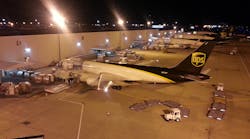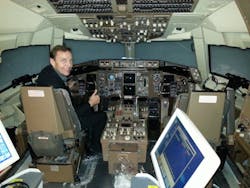Twenty freight aircraft can land within three of the wee small hours of the morning at the UPS Worldport package handling facility in Louisville, Ky. But if bad weather suddenly makes that feat potentially unsafe, either toward the beginning or the end of one of those routes, dispatchers may have enough time to put extra fuel on the affected aircraft so it can be rerouted or flown above the weather until conditions are safe. They can also space aircraft apart so they don’t all arrive at the same time when such changes are made.
This was one of the things I learned while touring the UPS Worldport hub in Louisville, Ky. This operation turns more than 130 aircraft daily and processes an average of 1.6 million packages a day. But what’s really interesting is to see these operations at night—or rather, at 2 a.m. At that hour there is a team of people monitoring routes and the conditions affecting those routes. One of those people is Jim Cramer, a meteorologist for UPS, who keeps an eye on weather conditions around the world—wherever there are UPS jets loaded with freight heading somewhere to deliver it. UPS generates its own weather reports in real time rather than relying on government-issued forecasts.
“Government-issued forecasts are generated every 24 hours for everybody. We can focus on specific issues in real time and give dispatchers an opportunity to reroute."—Jim Cramer, UPS meteorologist“Government-issued forecasts are generated every 24 hours for everybody,” Cramer said during our tour of the situation room at this hub. “We can focus on specific issues in real time and give dispatchers an opportunity to reroute.”
Low visibility conditions are the worst enemy of an air freight company because they can develop quickly, making them hard to forecast. At least a half-mile of visibility is required to make a safe landing, and if that’s not possible, dispatchers can reroute a jet to the nearest alternate airport and stage delivery trucks there to receive those shipments and complete the delivery. That’s where tailored forecasts come in handy.
UPS also has a “hot spares” program. The night of our tour there were 11 jets staged around the world, ready to rescue any package volume that was in jeopardy of not being loaded onto an aircraft for overnight delivery. This is an expensive insurance policy. The carrier pays crew members to stand by and when they are needed, they have only 30 minutes to launch and get that volume.
We blogged recently how many companies are being overwhelmed by “Big Data.” A facility like this has a growing hunger for Big Data and can’t get enough. That’s why UPS is planning to add more weather-observing sensors to its aircraft.
“Most weather information comes from the surface of the earth and from weather balloons,” Cramer said. “With aircraft data, more measured information gets fed to the computer weather modeling centers for greater routing accuracy.”
Climatological weather isn’t the only thing the staff in this situation room watches. They also get security alerts and briefings every day so they can route around political trouble spots in other countries.
The situation room was the first stop on our tour of other portions of the greater than 5 million square feet of Worldport operations. Along the way our hosts were brave enough to put me in the cockpit of one of their freight simulators (below). If you’d like to share in some of the other early-morning sights we saw, join us HERE in our gallery of highlights.




